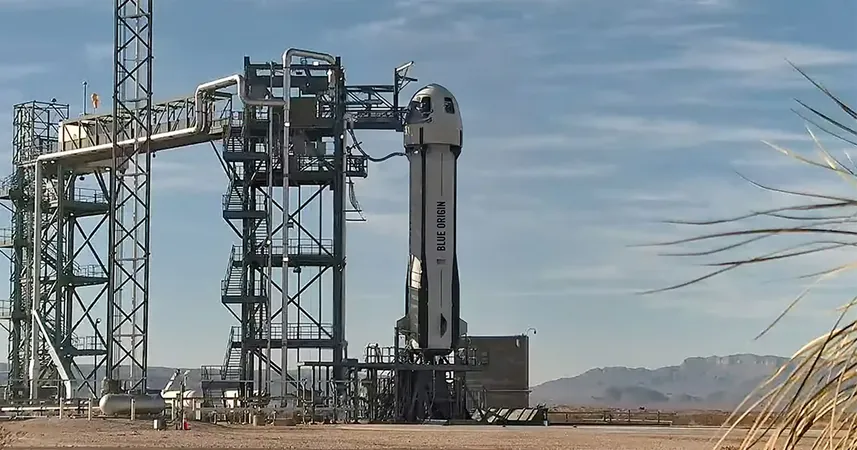
Revolutionizing Space Traffic: ESA's CREAM Project Takes Flight
2025-08-13
Author: John Tan
As Earth's orbit becomes increasingly packed, the European Space Agency (ESA) is taking bold steps to safeguard our satellites and ensure the long-term viability of space.
With over 11,000 active satellites currently orbiting our planet, and predictions of tens of thousands more in the near future, along with an astonishing 1.2 million pieces of debris larger than 1 cm, the danger of collisions in space has reached critical levels.
Enter the Collision Risk Estimation and Automated Mitigation (CREAM) project—ESA's groundbreaking initiative designed to tackle the challenge of space traffic management head-on.
A Game-Changer for Space Traffic Management
Traditionally, satellite operators manually assess potential threats, design avoidance maneuvers, and coordinate with one another—an arduous and often fragmented process.
CREAM aims to flip the script by automating collision risk assessments, maneuver planning, and coordination, creating a streamlined, tech-savvy approach to managing space traffic.
The vision? To reduce false alarms, expedite decision-making, and lighten the workload for operators, ultimately enhancing mission safety.
Building Connections in the Cosmos
One of CREAM's most ambitious features is its capacity to forge a network connecting a diverse array of stakeholders—from satellite operators to space surveillance services and regulatory bodies.
This interconnected network facilitates quicker and more transparent decision-making, especially when two active satellites find themselves on a collision course.
In some scenarios, CREAM could even negotiate maneuver agreements between operators with minimal human intervention.
Should conflicts arise, the system is equipped to escalate issues to a mediation service, ensuring fairness and flexibility while protecting valuable space assets.
From Ground Tests to the Final Frontier
Since its launch in 2020, the CREAM project has reached a pivotal milestone. Under the guidance of GMV, with contributions from Guardtime, the foundational elements are being integrated into a comprehensive platform.
Currently, the ground-based prototype can already issue collision alerts, suggest practical avoidance maneuvers, and facilitate inter-operator coordination. The next phase involves an expanded pilot program to enhance decision-support technologies.
Simultaneously, ESA is gearing up for in-orbit demonstrations, including 'piggyback missions' where CREAM will be deployed as a digital payload, along with dedicated missions to test its full capabilities in real space conditions.
Shaping the Future of Space Regulations
Beyond immediate collision risks, CREAM has the potential to influence the future of space traffic regulations significantly.
The establishment of 'rules of the road' in space has often been bogged down by a classic dilemma: it’s tough to enforce guidelines without the technology to execute them, and tech adoption stalls without a clear regulatory framework.
By embedding CREAM in spacecraft, operators can easily comply with emerging best practices and norms, while regulators gain a robust monitoring tool to ensure adherence.
CREAM's flexible design allows non-technical users to adjust standards as regulations evolve, ensuring it remains relevant in our ever-changing orbital landscape.
Towards a Safer Cosmic Future
With mega-constellations, commercial launches, and private operators flooding low-Earth orbit, effective space traffic management has become an urgent necessity.
ESA's CREAM project represents a monumental leap toward a coordinated, automated, and equitable solution for preventing collisions, minimizing space debris, and safeguarding our orbital environment for future generations.
If CREAM proves successful, it could serve as the backbone of an international framework for space safety, demonstrating that with the right tools, technology, and solidarity, humanity can explore and utilize space without transforming it into an overflowing junkyard.

 Brasil (PT)
Brasil (PT)
 Canada (EN)
Canada (EN)
 Chile (ES)
Chile (ES)
 Česko (CS)
Česko (CS)
 대한민국 (KO)
대한민국 (KO)
 España (ES)
España (ES)
 France (FR)
France (FR)
 Hong Kong (EN)
Hong Kong (EN)
 Italia (IT)
Italia (IT)
 日本 (JA)
日本 (JA)
 Magyarország (HU)
Magyarország (HU)
 Norge (NO)
Norge (NO)
 Polska (PL)
Polska (PL)
 Schweiz (DE)
Schweiz (DE)
 Singapore (EN)
Singapore (EN)
 Sverige (SV)
Sverige (SV)
 Suomi (FI)
Suomi (FI)
 Türkiye (TR)
Türkiye (TR)
 الإمارات العربية المتحدة (AR)
الإمارات العربية المتحدة (AR)